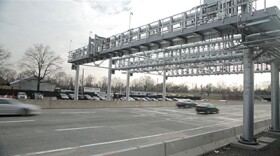Motorists who travel the I-190 can expect overnight and weekend lane closures on Grand Island over the next few weeks. The first phase of replacing the Grand Island Toll Barriers is underway.
Improvements are being made to the Thruway near the North and South Grand Island Bridges to accommodate a new cashless tolling system. Grand Island Supervisor Nate McMurray helped push the state to make the change.
"The tolls created a barrier to economic progress, just to our everyday life, that was unreasonable," McMurray said.
The new high-speed cashless system, he says, won't fix every traffic jam on the old bridges. But McMurray says, it's a step in the right direction for Western New Yorkers who rely on the bridges. According to the state, 65,000 vehicles pass through the Grand Island Toll Barriers every day. McMurray says his long-term goal is to understand how much money is being generated.

"Having a toll is not in and of itself offensive, if it's a reasonable toll, because we need to take care of those bridges, we need to do infrastructure improvements. But the problem I've always had is, how is the toll spent? Is there transparency? Is there accountability? And those are lingering questions that we need to have resolved. But I think when you're having this type of improvement, or this type of achievement, I think it's hard to complain at the moment. But I do think, in the long run, we need to have that discussion," McMurray said.
Once the old toll barriers are removed, and the new cashless system is fully operational, it's expected to save drivers about 200 minutes a year. Work is expected to be complete in March 2018.






